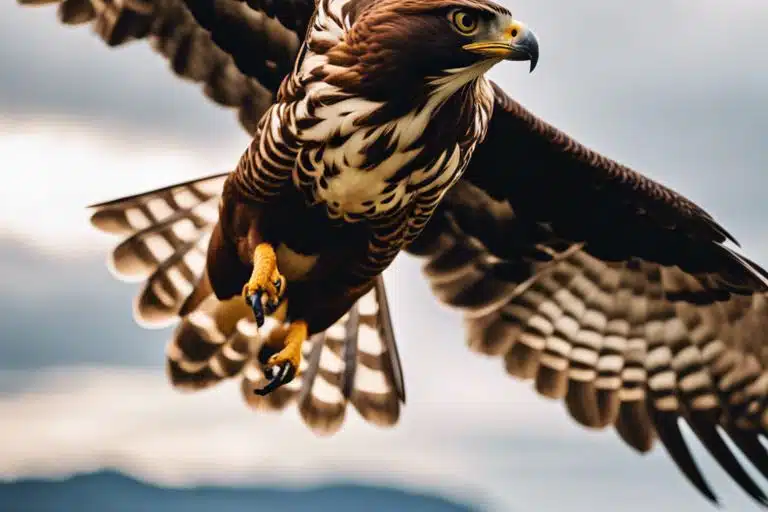Most fascinating in avian predators are the Birds of Prey and Raptors, known for their impressive hunting skills and unique dietary preferences. These magnificent creatures target various prey types ranging from large mammals to small birds, showcasing a diverse array of food choices. From the powerful Eagle to the sleek Falcon, each species has honed its hunting prowess to specialize in specific food sources. Join us as we research into the world of Birds of Prey and uncover the intricacies of their varied diets. Explore how these majestic raptors play a critical role in the ecosystem by maintaining a delicate balance in nature through their predatory behaviors.
Key Takeaways:
- Birds of Prey Diet: North American Birds of Prey, such as falcons, hawks, and eagles, primarily consume mammals and birds, with varying proportions depending on the species.
- Specialized Predators: Raptors like the Sharp-shinned Hawk and Cooper’s Hawk specialize in hunting smaller birds, while larger birds like the Bald Eagle target mammals like rabbits and ducks.
- Varied Diet: The diets of Birds of Prey are varied and may include reptiles, amphibians, and invertebrates, showcasing their adaptability and resourcefulness in pursuing different prey types.
- Species Adaptations: Birds of Prey, like the Osprey, have evolved unique hunting strategies, such as diving talons-first for fish, and using specialized beaks like Snail Kites to extract snails from their shells.
- Ecological Role: Vultures play a vital role as carrion feeders, assisting in ecosystem sanitation by consuming carrion and aiding in the recycling of nutrients.

The Variety of Birds of Prey and Their Diets
There’s The Avian Diet Database as a source of quantitative information on the dietary habits of birds of prey, shedding light on their diverse feeding preferences and behaviors.
Overview of Key Raptors
Their varied diets showcase a range of hunting strategies, with raptors like Ospreys targeting fish, while American Kestrels focus on large insects. From larger birds like the Bald Eagle preying on fish to the stealthy hunting techniques of the Sharp-shinned Hawk capturing small birds, each raptor species has evolved its own unique approach to securing food.
What Birds of Prey Eat
Birds of prey such as Ospreys exhibit specialized hunting behaviors, diving talons-first into the water to catch fish. Their diets consist mainly of fish, with occasional catches of snakes or small mammals. Their sharp talons and keen eyesight make them efficient fishers, showcasing their ability to adapt their hunting techniques to their main food source.
Feeding Behaviors and Strategies
Hunting Techniques of Raptors
Feeding on a variety of prey items, Raptors utilize diverse hunting techniques to capture their meals. Species like the Sharp-shinned Hawk and Cooper’s Hawk are known for their stealthy approach, swiftly maneuvering through dense vegetation to catch smaller birds like doves and pigeons. In contrast, falcons such as the Peregrine Falcon rely on their high-speed aerial pursuits to capture agile prey like small birds or bats, showcasing their incredible hunting agility.
Adaptations for Diet and Hunting
One of the critical Adaptations that aid Birds of Prey in securing their meals is specialized beaks, talons, and flying capabilities. For instance, the Osprey showcases its unique diving abilities to catch fish, thanks to its sharp talons and streamlined body. Additionally, raptors like the Golden Eagle possess powerful talons and keen eyesight, enabling them to spot and capture larger prey like ground squirrels with precision.
Conservation and Human Impact
Protecting Birds of Prey Through Education and Preservation
One of the key ways to safeguard the populations of birds of prey is through education and preservation efforts. By raising awareness about the importance of these majestic creatures in maintaining the ecological balance, we can inspire people to take action for their conservation. This can include habitat preservation, reducing human disturbances in nesting areas, and promoting responsible outdoor activities to minimize human impact on their habitats.
The Role of Rehabilitation Centers and Bird Sanctuaries
On the front lines of bird of prey conservation are rehabilitation centers and bird sanctuaries. These centers play a critical role in caring for injured or orphaned birds, providing them with medical treatment, rehabilitation, and eventually, release back into the wild. Bird sanctuaries also serve as safe havens for birds that cannot be released due to permanent injuries. Their work is vital in preserving the populations of these magnificent raptors and ensuring their health and well-being.

How to Support Birds of Prey
Responsible Bird Feeding Practices
With a diverse range of diets, it’s crucial to practice responsible bird feeding for birds of prey. All bird feeders should be kept clean to avoid spreading disease among species. Avoid using insecticides near bird feeders and opt for natural food sources to keep the birds’ diet healthy and balanced.
Creating Bird-Friendly Habitats
Feeding and creating bird-friendly habitats are important for supporting birds of prey. This means providing a suitable environment with ample perches, birdhouses, and natural food sources such as insects, small mammals, and reptiles. Maintain green spaces with native plants to attract a variety of prey items for the birds to feed on.
To wrap up
With these considerations of the diverse diet and hunting habits of North American Birds of Prey and Raptors, it is evident that these avian predators have developed specialized skills and strategies to target specific prey types. From the speed and agility of Falcons hunting birds in open skies to the stealthy Accipiter Hawks targeting smaller birds in dense forests, each species plays a unique role in their ecosystem. Whether it’s the fish-catching Osprey or the carrion-consuming Vultures, these birds exhibit remarkable adaptability and resourcefulness in securing their food sources. Understanding the dietary preferences and hunting techniques of these magnificent creatures provides us with valuable insights into the intricate relationships within the natural world.

FAQ
Q: What do Birds of Prey Eat?
A: Birds of prey, also known as raptors, feed primarily on other animals. They consume a variety of prey including mammals, larger birds, reptiles, amphibians, and even invertebrates.
Q: What are Some Common Prey Items for Birds of Prey?
A: Birds of prey have diverse diets depending on the species. Some common prey items include small birds, rodents like mice and voles, doves, rabbits, squirrels, insects, fish, and carrion.
Q: How Do Birds of Prey Hunt and Capture Their Prey?
A: Birds of prey use a range of hunting strategies including perching and diving. They may swoop down from the air to catch prey with their talons, use stealth and agility to ambush, or hover to spot potential meals. Their beaks and talons are specialized for grabbing and consuming a variety of prey.
As a bird enthusiast with a passion for sharing the wonders of our feathered friends. As a writer and nature lover, I'm thrilled to connect with fellow bird buffs and inspire others to take flight into the fascinating world of birds. Let's wing it together!


